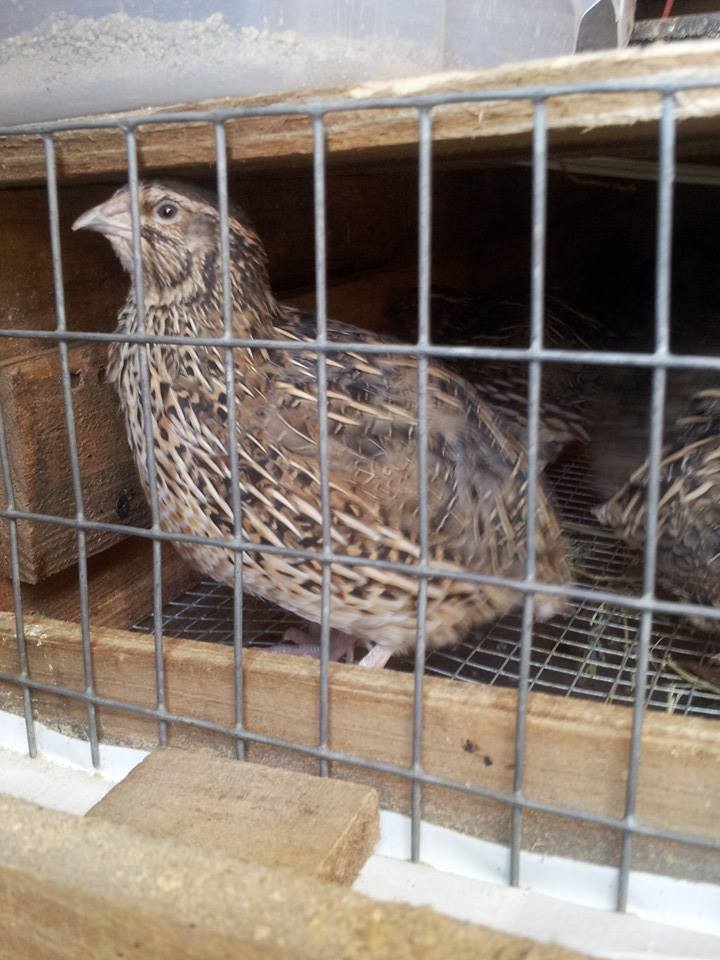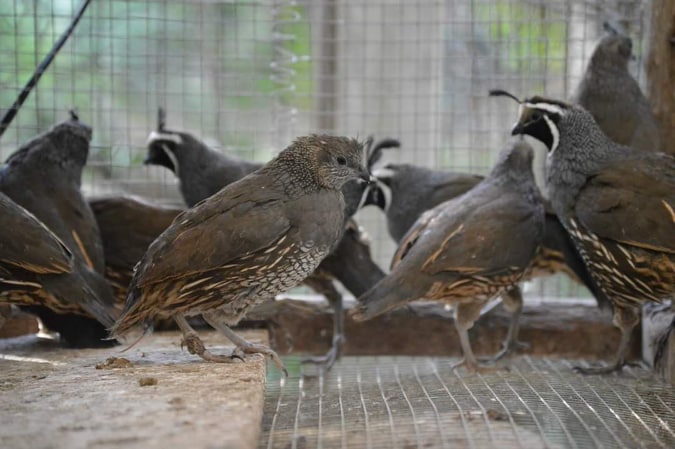Button, Bobwhite, Coturnix, Jumbo; how do you know which quail are the right fit for you? Alexandra Douglas has lots of answers for your questions.
When I was a child, I always dreamed of owning quail. I visited a family friend who bred parrots and saw these cute little birds on the bottom of the finch aviaries. The breeder told me the birds were button quail and that they did well as bottom feeders and made great little pets. I wanted them and begged my parents, thinking the birds could just free range in my bedroom. Obviously, my parents said no.
When I attended college, I studied Animal Science and Poultry, though with a focus on commercial operations. There wasn’t much on quail, except for a little information on the Japanese Coturnix quail, sometimes used for production. Just like with the button quail, I fell so in love that I’ve now developed my own breed lines and written two books about quail.
In this article, I’m sharing some of the knowledge I’ve gleaned about these amazing birds, so you can pick the ones best suited to your space and lifestyle. Quail are a versatile bird and you’ll easily find the right fit for you.
New World and Old World Quail
Before going into the common species of quail and what they are used for, it’s helpful to understand the difference between a New World and Old World quail. Both are in the order Galliformes, however, they’re of different families. New World quail are in the Odontophoridae family. They tend to be species found in the wild and maintain their undomesticated traits, even when caged.
Old World quail are in the Phasianidae family. They’ve been bred (domesticated) for calm temperaments and as dual-use (meat and eggs) birds.
Fun Facts about New World Quail
- New World quail fly well and roost in trees/perches.
- Most species are sexually dimorphic, meaning adult males and females look different.
- The most common New World quail is the northern bobwhite quail (Colinus virginianus).
- They’re shy, flighty birds.
- New World quail consist of 32 species.
Fun Facts about Old World Quail
- Old World quail are ground dwellers. They don’t roost in trees or on perches.
- Sexual dimorphism exists in some species, with larger and more colorful males than females.
- A few species are used today as popular pets and for egg and meat production.
- The most common Old World quail are the Chinese blue-breasted quail or “button quail” (Coturnix chinensis) and the Japanese Coturnix (Coturnix japonica).
- The fastest producing Old World quail is the Japanese Coturnix.
When most people in the U.S. hear the word “quail,” they think of the northern bobwhite quail, which can make things a little difficult for quail breeders who carry several different species. Read through their material carefully and ask a lot of questions to understand exactly the type of quail they are selling. Here are some specifics on button quail, Japanese Coturnix and bobwhite quail to help you make some decisions.
Chinese Blue-Breasted Quail
The Chinese blue-breasted Quail is a common species of quail that is also known as “button quail.” Their scientific name is Coturnix chinensis. This little quail was the one I admired as a child. They got their name because the chicks are small and the size of a dime, making them “as cute as a button.”

King quail Button Quail Male and Female
Preferred Habitat
The birds do get territorial with newcomers; therefore, pair housing is recommended. Some people do house them in colonies, but you may see a drop in fertile egg production as there will be more fighting among the birds. These birds are ground dwellers, so make sure that you use a solid bottom in their cage not only because wire is hard on their tiny toes, but also, you won’t want their feet and legs to slip through the wire, risking injury. They can be housed with finches and doves, or you can simply use a cage designed for finches.
Mating
Chinese blue-breasted quail are a sexually dimorphic species. The males tend to be brighter in plumage with a bib on their face, and females tend to be more camouflaged and duller in plumage. Chinese blue-breasted Quail mature in 12 weeks. Unlike other quail, they are monogamous, which is why they do better when housed in pairs.
Eggs
The hens will lay eggs slightly larger than a jellybean. The eggs are solid in color with very light speckling and range from brown to a cream color, with some closer to purple.

The Chinese blue-breasted quail egg is on the far left. The center left egg is a Japanese Coturnix, while the right two eggs come from northern bobwhite quail.
Nutrition
Chinese blue-breasted Quail can be tamed, but they do get nervous. Although they will pick up seeds dropped from other birds, it’s still important to feed them based on their nutritional needs. They do well on the game bird feed that you can purchase at a local feed or farm store. You can supplement their diet with fresh fruits and vegetables, and provide them with a shallow bowl of grit so they can digest their food.
Despite their size and needs, they do make good “look at me” pets, as many of the males’ plumage is very vibrant and mesmerizing.
Japanese Coturnix Quail
Japanese quail (Coturnix japonica) are the most popular Old World quail, known for their meat and egg production. They are commonly called “Coturnix” as a nickname. This is the species that I specialize in on our homestead. Coturnix are used mainly for meat and eggs, though some folks keep them as pets like they do other birds. Some people see them as a mini-chicken because they are often raised for the same purposes, and are also quite tame. There are many strains and varieties, including the Jumbo lines, such as our selectively bred Stellar Jumbo line or the Texas A&M jumbos, and standard-sized quail such as the English white or rosetta. There are 33 different plumage variations.

Jumbo Coturnix
Eggs
A single hen will lay 300 beautiful speckled eggs each year, and maturity is at 6 weeks of age. Some strains will mature a little later, but not by much.
Housing
Coturnix don’t require much space. They can be housed in rabbit hutches, aviary cages, or outdoor pens (with closed tops). The rule of thumb for housing is to start with 1 square foot per bird. Some keepers prefer more space for their birds and may house their birds in an aviary setting. Coturnix are ground dwellers and do not roost. Compared with the Chinese blue-breasted Quail, they’re larger birds, therefore they can be housed on solid or wire flooring. They are shorter birds; therefore, it is easy to stack shorter cages for best efficiency for the producer or have a larger setting for a colony of Coturnix.
If you are looking for a bird for the homestead, with fast maturity and growth, and practical for a pet, meat, or eggs, the Coturnix is your perfect match.
Northern Bobwhite Quail
One of the most popular New World quail is the northern bobwhite quail (Colinus virginianus), known for the “bob-white” call the males make in the wild. Northern bobwhites inhabit the United States, Mexico, and the Caribbean. They are covey birds, like Coturnix. Bobwhites do come in many color varieties, making them a wonderful quail for the fancier as well as for their other uses.

Mating
They prefer to be in groups rather in pairs, however, males and females will partner up during the breeding season. Bobwhites can make decent pets, but their main use is for hunting and dog training, due to their flighty, shy behavior.
Eggs
They lay white eggs and are seasonal birds, meaning that they will lay fertile eggs during the spring months. The hens lay don’t lay as much as Old World quail because of this seasonal nature. They mature between 18 and 22 weeks of age. A hen generally will not lay the same season she’s hatched, and may not lay until the next year.
Housing
Being very flighty, bobwhites and their subspecies are best housed in large aviaries with lots of flight room. Many breeders will house them in large flight pens and avoid handling them, so they can make good birds to hunt for meat. Being shy, they do enjoy having brush, shrubs, and hidey spots. Perches and branches will be needed as the birds do roost. If you are looking for a more-flighty quail for hunting and dog training, then the northern bobwhite or its counterparts (giant and larger varieties) will be the best fit for you.
Types
Although the northern bobwhite quail is well-known, many quail keepers do like exotics. Some other popular species of exotic New World quail are the California valley quail, Gambel’s quail, blue scale quail, and Mearn’s quail (also referred as Montezuma quail). They’re mainly used for the fancier as “look at me” birds, and because they tend to be pricey, they’re often used as exhibition birds rather than meat or egg production birds. New World quail tend to lay white to beige eggs, with some speckles, depending on species.
The more exotic New World quail are also fun to raise. All make different sounds and are personable.
I raised most of these species throughout my quail-raising years and have found that the Old World quail are the ones for me, however, others may find both useful on their homestead to raise. Do make sure to check your state’s laws for any special permitting required.
Further Reading
I highly recommend Jodi McDonald’s A Closer Look at Button Quail to learn more about the 0Chinese blue-breasted quail. If you are new to raising quail, my newest book, The Quail Lady’s Guide to Raising Coturnix on the Homestead, is available for all stages of quail enthusiast. It is the prerequisite to my previous book, Coturnix Revolution. (Our Community Chickens Editor recommends all of these books!)
Alexandra Douglas was born in Chicago, Illinois. At age nine, she began raising psittacines (parrots). When she moved to Oregon for college in 2005, she majored in Animal Sciences at Oregon State University with an emphasis in pre-veterinarian medicine and poultry. Alexandra was hooked on quail as soon as she was handed a day-old pharaoh Coturnix. Currently, she owns Stellar Game Birds, Poultry, Waterfowl LLC, a poultry farm that sells chicks, hatching eggs, eating eggs and meat. She has been featured in Aviculture Europe and honored by the Heritage Poultry Breeder Association of America for her research on quail. Her book on Japanese Quail, Coturnix Revolution, is a comprehensive guide to raising and understanding these domesticated fowl. Visit her website or follow her on Facebook.













4 Comments
What do I feed my Quail?
Great article, can quail coexist with chickens?
Thanks
Hi John,
Quail and chickens are both predominately ground birds who like brush and cover. If you want to keep them in the same area, it needs to be large enough so that they both have the areas they need. For instance, your chickens will stay in a fenced area while the quail will easily fly over the fence and disappear into the underbrush, never to be seen again. The quail need undisturbed space to nest, that the chickens might scratch up and destroy in their search for bugs.
Your quail will do better if they are in smaller, completely enclosed cages with fairly low roofs. You could keep quail cages in a chicken yard, but probably don’t want to just put all the birds into the same coop and run.
What do I feed my baby quail